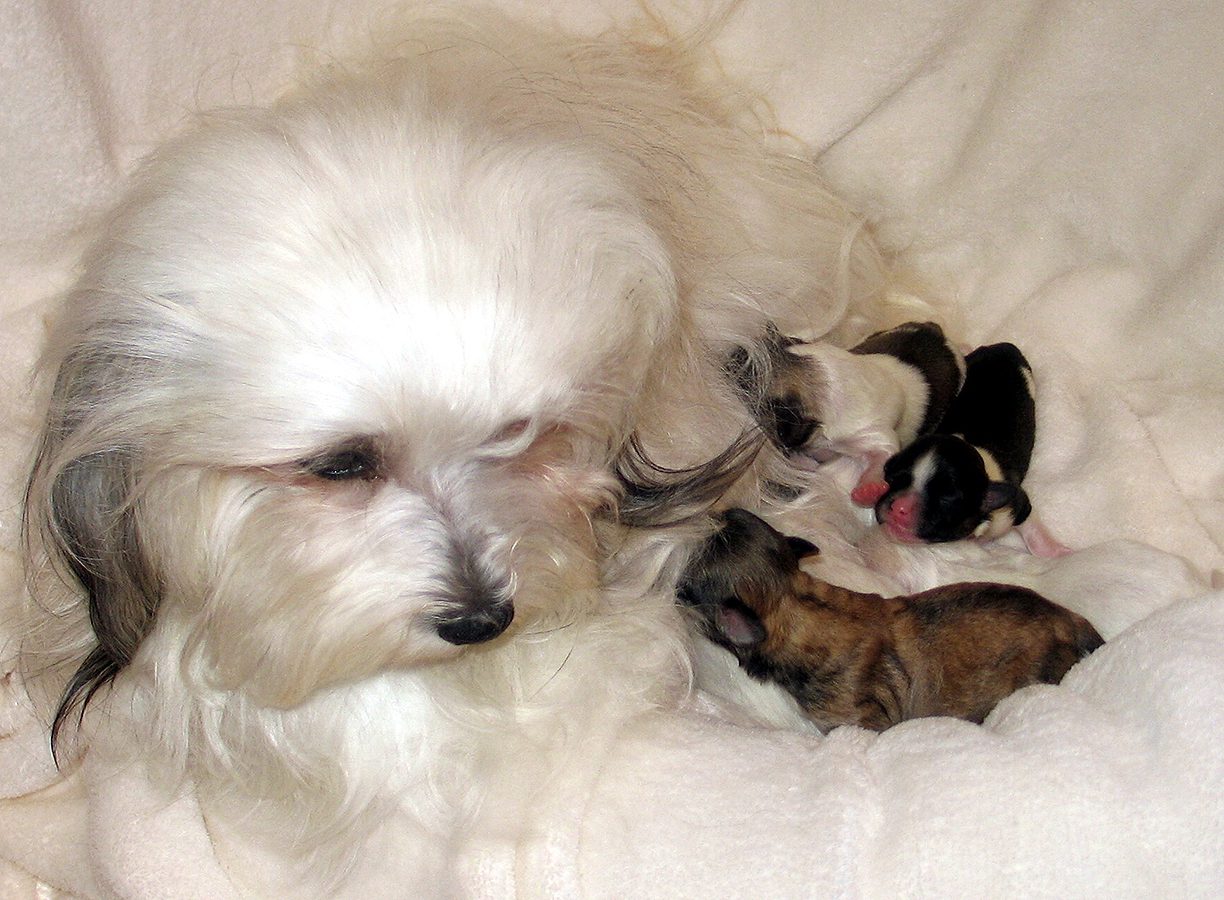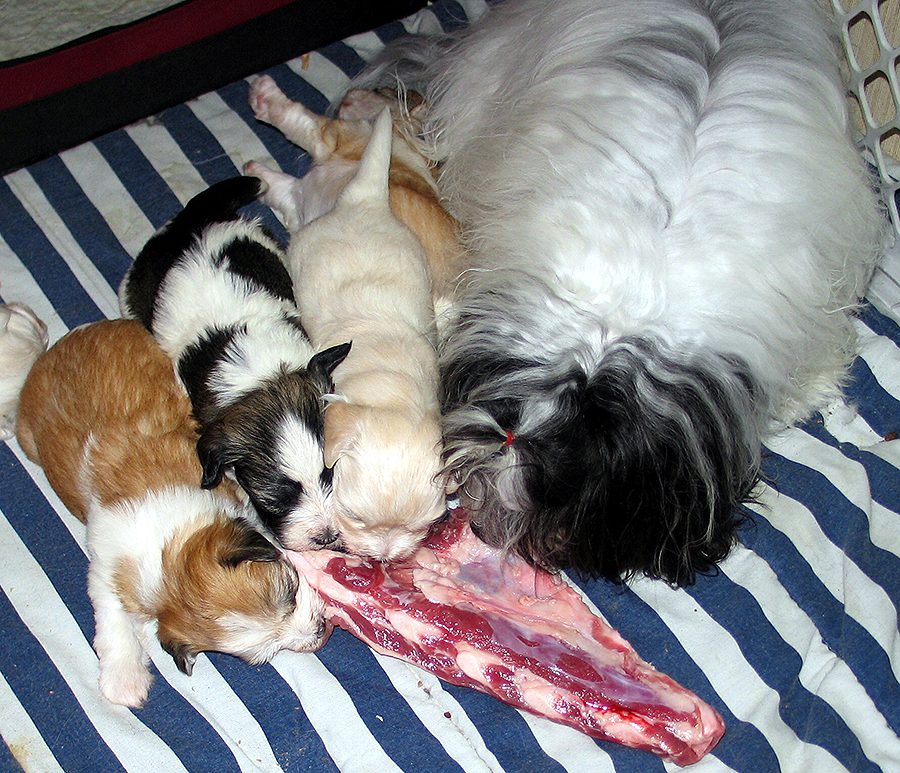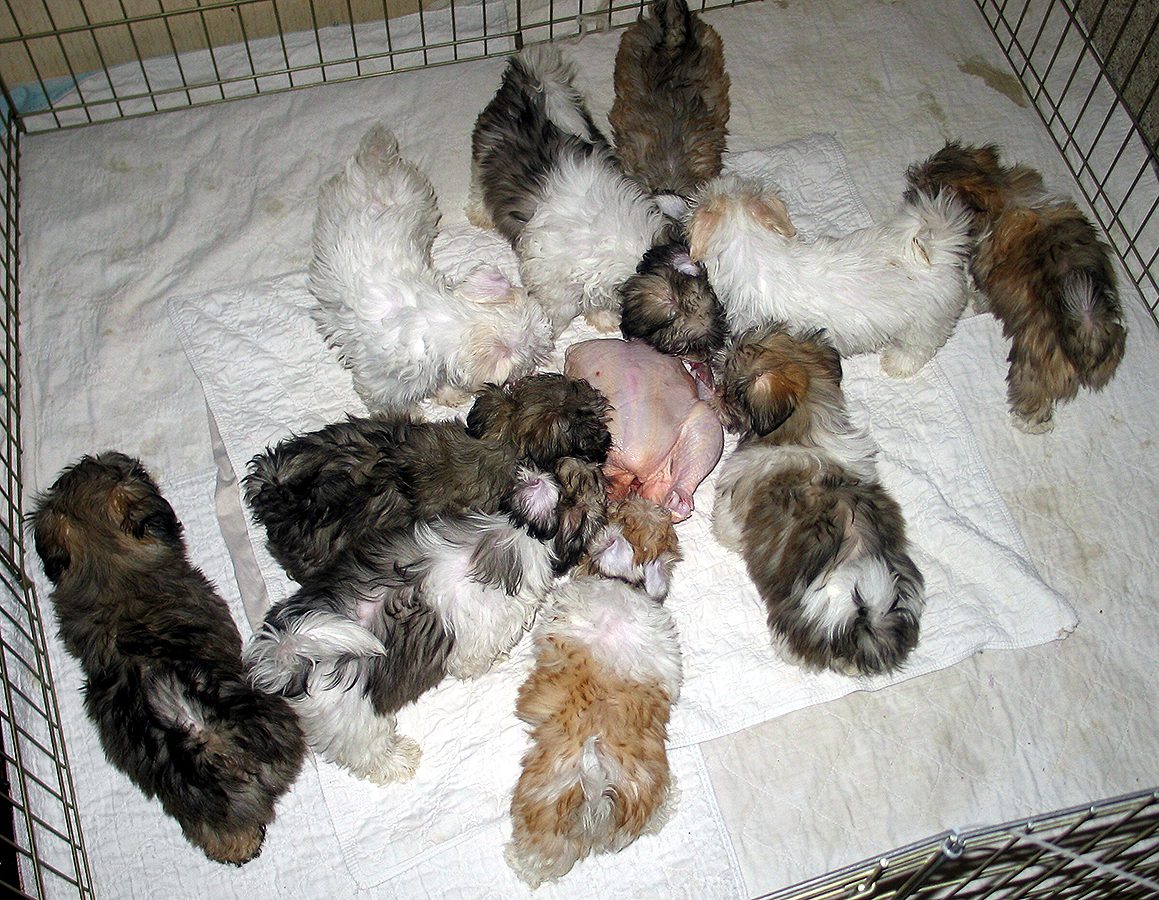Havana Silk Havanese - AKC Breeder of Merit
Natural Rearing & Nutrition
Natural Rearing, in its most fundamental sense, involves embracing and facilitating nature’s guidance regarding nutrition, health, and overall well-being for Havana Silk Havanese.
Before bringing home your Havanese puppy, many crucial decisions have already been made. As a responsible breeder, I play a significant role in shaping the destiny of each puppy I bring into the world. My decisions encompass aspects such as the puppy’s lineage, parentage, environment, feeding practices, and the duration its mother nourished it before being weaned.

Importance of Mother’s Milk
An unparalleled sense of warmth and joy accompanies the sight of a litter of newborn puppies, all nestled together, with their tails wagging as they nurse from their mother. Mother’s milk is the first form of sustenance the puppies will receive, containing an array of essential components such as vitamins, minerals, fats, proteins, carbohydrates, hydration, and immunological factors. This foundation sets the stage for the puppy’s long and flourishing life.
However, the journey begins even earlier, with the careful selection of the ideal breeding pair. Optimal results are achieved when this pair has been raised naturally, and it is even more advantageous if their parents were also raised naturally. Additionally, feeding them a diet that aligns with their species’ nutritional requirements further enhances their overall well-being.
Natural Rearing means allowing the mother and her puppies to determine when the weaning process should occur, recognizing that some puppies may require more time with their mother. In contrast, others are ready to become independent earlier. During this intimate bonding experience, the puppies acquire more than just nourishment. Puppies that naturally wean are generally healthier, better adjusted, and easier to train than those abruptly separated from their dams at a predetermined age, such as six weeks, simply because it is considered the “norm.”
Havana Silk Havanese puppies remain with their mothers for up to 10 weeks, regardless of whether they are nursing. During that time, they receive valuable education from their mothers, including housebreaking and bite inhibition.
More Than Just Diet

At the core of Natural Rearing lies the establishment of a resilient immune system. By providing raw meaty bones and organs, fresh air, clean water, minimal stress, appropriate exercise, and abundant love, dogs are fortified from within, enabling them to combat various diseases effectively. Embracing natural alternatives whenever possible, Natural Rearing supports the development of robust immunity, granting each dog the opportunity to live a vibrant and lengthy life.
Species-Appropriate Diet
Natural Rearing also entails acknowledging the inherent anatomical design of canines to determine their dietary requirements. Anatomically, dogs are carnivores, evidenced by their sharp carnassial teeth, powerful jaws, potent stomach acids, and short intestines—characteristics shared with other carnivores.
Cats, including lions and domestic cats, are known as obligate carnivores. As obligate carnivores, their digestive systems are not adapted or evolved to process carbohydrates. On the other hand, dogs are classified as facultative carnivores, which means they can consume plant matter but are not true omnivores. It’s important to note that dog food producers who claim dogs are omnivores usually have a financial incentive, often related to selling carbohydrate-heavy diets. However, such diets are unsuitable for a facultative carnivore like a dog.
Dogs are neither obligate omnivores like humans and bears nor herbivores like deer, rabbits, and horses. It seems illogical to feed a horse or a rabbit a slab of steak, right? Yet, this is the flawed reasoning employed in producing commercial dog foods. Most commercial dog foods would be more suitable for rabbits than for dogs.

Carnivores have evolved to thrive on the consumption of animal meat to maintain optimal health. Unfortunately, commercial dog foods predominantly consist of grains, fillers, and, more recently, harmful substances, rendering them unsuitable for supporting the well-being of carnivores.
Ensure that your dog’s dietary needs align with its status as a facultative carnivore. While they may consume various plant foods to prevent starvation, providing them with meat, including backbone and organs, is crucial for optimal health and well-being.
Backed-up by Scientific Research
The British Journal of Small Animal Practice published a study suggesting that processed pet food suppresses the immune system and contributes to diseases affecting the liver, kidneys, heart, and other organs. Dr. Kollath of the Karolinska Hospital in Stockholm conducted an animal study in which young animals fed cooked and processed foods initially appeared healthy. However, as they reached adulthood, they began to age more rapidly than usual and developed symptoms of chronic degenerative diseases.
Conversely, a control group of animals raised on raw foods aged more slowly and remained free from degenerative diseases. The AAFCO (American Association of Feeding Control Officials) feeding standards require that, in a 26-week trial involving at least eight dogs, no more than two deaths occur as evidence of feed-ability. This constitutes scientific support for the notion that no genuinely beneficial dry dog food exists.
Why do pet food companies constantly strive to develop new and improved formulas? They lack a clear understanding of what they are doing and what truly benefits dogs.
Learn More About Natural Rearing
Experts Comment on Natural Rearing
Dr. Ian Billinghurst, B.V.Sc.(Hons), BSc., Agr., Dip.Ed.
“The sad truth is that prepared pet foods help provide patients for vets. Raw chicken does, of course, carry bacteria, e.g., salmonella. These are of absolutely no consequence to a healthy dog. As a veterinary student in the early seventies, I found it hard to understand why Aussie vets fewer and simpler dog and cat diseases had to deal with than the Americans. It seemed to make the Aussie vet somehow inferior. We did not need to be trained to the same high complexity and sophistication. There was a simple explanation. At that time, over seventy percent of Aussie dogs were still fed raw bones and scrapes. They were still pretty healthy. American dogs had been eating processed food and no bones for decades. They had developed a wide range of problems. Their vets had been forced to develop complex diagnostic and therapeutic tools to deal with them. I need not have worried. Our dogs’ disease problems are increasing on par with their increasing consumption of processed and cooked foods. We Aussie vets must now be as good as our American counterparts to deal with them. There are many reasons why commercial pet foods have never been close to a dog’s natural diet. Those reasons include that they are based on grain and cooked.”
Kymythy Schultze, Clinical Nutritionist for Dogs, Cats, and Humans
“Salmonella has even been found in samples of commercial pet foods & treats. Bacteria is not a problem for a pet with a strong immune system, & a strong immune system is encouraged by eating species-appropriate raw food.”
Tom Lonsdale, DVM
“Raw meaty bones promote health. Dingoes and feral cats keep themselves healthy by eating whole carcasses. The closer you come to this ideal for pet dogs and cats the better. As the natural pet food industry increases, so the artificial industry, together with its harmful effects, should go into decline… No more slurping of canned stew, no more rattle of dry pellets; instead, the sounds of nature, the crunching of raw meaty bones.”
Dr. Wendell O. Belfield, DVM
“Their pets may have diarrhoea, increased flatulence, a dull hair coat, intermittent vomiting or prolonged scratching. These are common symptoms associated with commercial pet foods.” In 1981, as Martin Zucker and I wrote How to Have a Healthier Dog, we discovered the full extent of negative effects that commercial pet food has on animals. In February 1990, San Francisco Chronicle staff writer John Eckhouse went even further with an expose entitled “How Dogs and Cats Get Recycled into Pet Food”.
Dr. Randy Wysong, DVM
“The very best way to feed pets is to turn them loose to eat their natural prey. Nutrition is serious health business. The public is not well served by exclusively feeding products from companies without any real commitment to health… or knowledge of how to even achieve that. Recent studies have shown processed foods to be a factor in increasing numbers of pets suffering from cancer, arthritis, obesity, dental disease and heart disease.”
Dr. Charles E. Loops, DVM
“The best diet is a raw food diet. Science Diet & Hill’s dog & cat food products are not good diets. They use chemical preservatives that have been shown to cause problems in some animals & they use by-products, which are words on the ingredient label that need to be avoided at all costs. This generally means food not utilized for human consumption.”
Edward Howell, MD
“Among the many thousands of species of creatures living on this earth, only humans & some of their domesticated animals try to live without enzymes. And only these transgressors of nature’s law are penalized with defective health. It is not surprising that dogs (and cats) have many human diseases since they are given only canned or packaged, heat treated, enzyme free food.”
Dr. Alicia McWatters, Ph.D.
“Fresh, raw foods contain the highest level of enzymes and these enzymes assist in digestion. Cooked foods and dry convenient diets have been denatured and are devoid of enzymes: life-promoting elements. While they may maintain life they do not promote optimum health or longevity!”
Nick Thompson BSc. (Hons), BVM&S, VetMFHom, MRCVS
“Dogs should eat raw food – raw meat and bones, vegetables and fruit. If they were meant to eat processed, sterilized food, they would have evolved with tin openers instead of dew claws.”
Dr. Donald Strombeck, Phd, DVM
“If salmonella really is a problem, then we should be just as concerned with processed pet food. Salmonellae has been found in commercial pet foods, something the public never learns.”
Dr. Richard Pitcairn, DVM
“When I began to suggest the feeding of raw meat I found animals becoming more healthy even without other treatment. Indeed, I have frequently had the report that people find their animals become healthy when they make this change and diseases for which they were hoping to have treatment (on a waiting list) have disappeared. Since that time, other veterinarians have told me similar things about the use of raw meat. I do not have numbers but I think the veterinarians recommending raw meat in the US are in the hundreds. My experience, albeit clinical and not based on studies, is that my patients have improved health on a raw diet. Furthermore, I have not seen significant parasite problems. Dogs and cats, being carnivores by nature, are meant to eat raw meat and do not have a problem doing so.
Although we have come to accept commercial foods as being normal or natural ways to feed animals (and indeed ourselves), in fact they are not. They are simply what we’ve gotten used to in the last few decades. But nothing we can produce commercially ever can rival those mysteriously complex foods manufactured for eons by nature itself.
All processed pet foods – whether sold in cans, bags, or frozen packages, in either giant supermarket chains or local health food stores – are missing something that seems to me to be one of the most important “nutrients” of all. This key ingredient is something nutritional scientists have practically ignored. But when it’s there, you and I can know it and feel it. It is a quality found only in freshly grown, uncooked whole foods. It’s life energy.
The many objections we can make about the nutritional quality of animal convenience foods boil down to two basic types: these foods don’t contain things we wish they did, and do contain things we wish they didn’t… The two basic problems are linked together as an unhappy pair because the presence of various toxins and pollutants actually increases the body’s needs for high quality nutrients necessary for combating or eliminating these contaminants. When the overall nutrition is already lower that it should be, we are inviting trouble.”
Christina Chambreau, DVM
“Meat should be raw. Cooking destroys enzymes and denatures the proteins rendering them less digestible to cats and dogs. Dogs and cats need raw meat to be really healthy and even the best processed foods cook their good ingredients, & most commercially available foods, even the expensive ones, use the cheapest ingredients (that means dead, diseased and decaying meat & by-products).”
William Pollak, DVM
“Health is an inevitable by-product of natural raw foods for our pets. Survival is insured by commercial food; nothing more; not health, not the robustness for life. The results of a clinical trial suggest that 74.7% of common diseases in dogs and 63% of common diseases in cats can be eliminated without medical intervention over a period of one year with proper diet modifications and an understanding of the healing process as exhibited through healing episodes. Approaching disease from the perspective of health is the most powerful means of eliminating disease. Poor fuel makes for little momentum in life. The commercial food we are feeding is the disease we are treating – so treat on and on, curing one disease after another, again and again. In the wild, no one cooks for the coyote or wolf; no one brushes their teeth. Their foods are raw and unprocessed. Eating supermarket pet foods is like eating cardboard. Our pets just get by on them and the foods lack any real vitality for the flourishing of health. Life is designed to be lived in vitality; surviving is living a slow death even before departure from the body.”
T.J. Dunn, DVM
“Modern man has modified a number of characteristics of the canine. But there’s one thing man has not altered… the basic nutrient requirements of the dog. Dogs need today essentially the same nutrients that their predecessors required eons ago. That is precisely why there has been so much notice given to the practice of feeding dogs (and cats, too!) raw meat and other unprocessed foods. There is ample proof that today’s pet dogs and cats DO NOT thrive on cheap, packaged, corn-based pet foods. Dogs and cats are primarily meat eaters; to fill them up with grain-based processed dry foods that barely meet minimum daily nutrient requirements has proven to be a mistake. And the fact that some pet foods have artificial colors and flavors added simply reveals the trickery needed to coax dogs and cats into consuming such material.”
British Journal of Small Animal Practice
“A growing number of vets state that processed pet food is the main cause of illness and premature death in the modern dog and cat. In December 1995, the British Journal of Small Animal Practice published a paper contending that processed pet food suppresses the immune system and leads to liver, kidney, heart and other diseases. This research, initially conducted by Dr. Tom Lonsdale, was researched further by the Australian Veterinary Association and proven to be correct.”
Russell Swift, DVM
“Grains are NOT part of the natural diet of wild dogs and cats. Carnivores cannot maintain long term production of the quantity of amylase enzyme necessary to properly digest and utilize the carbohydrates.”
